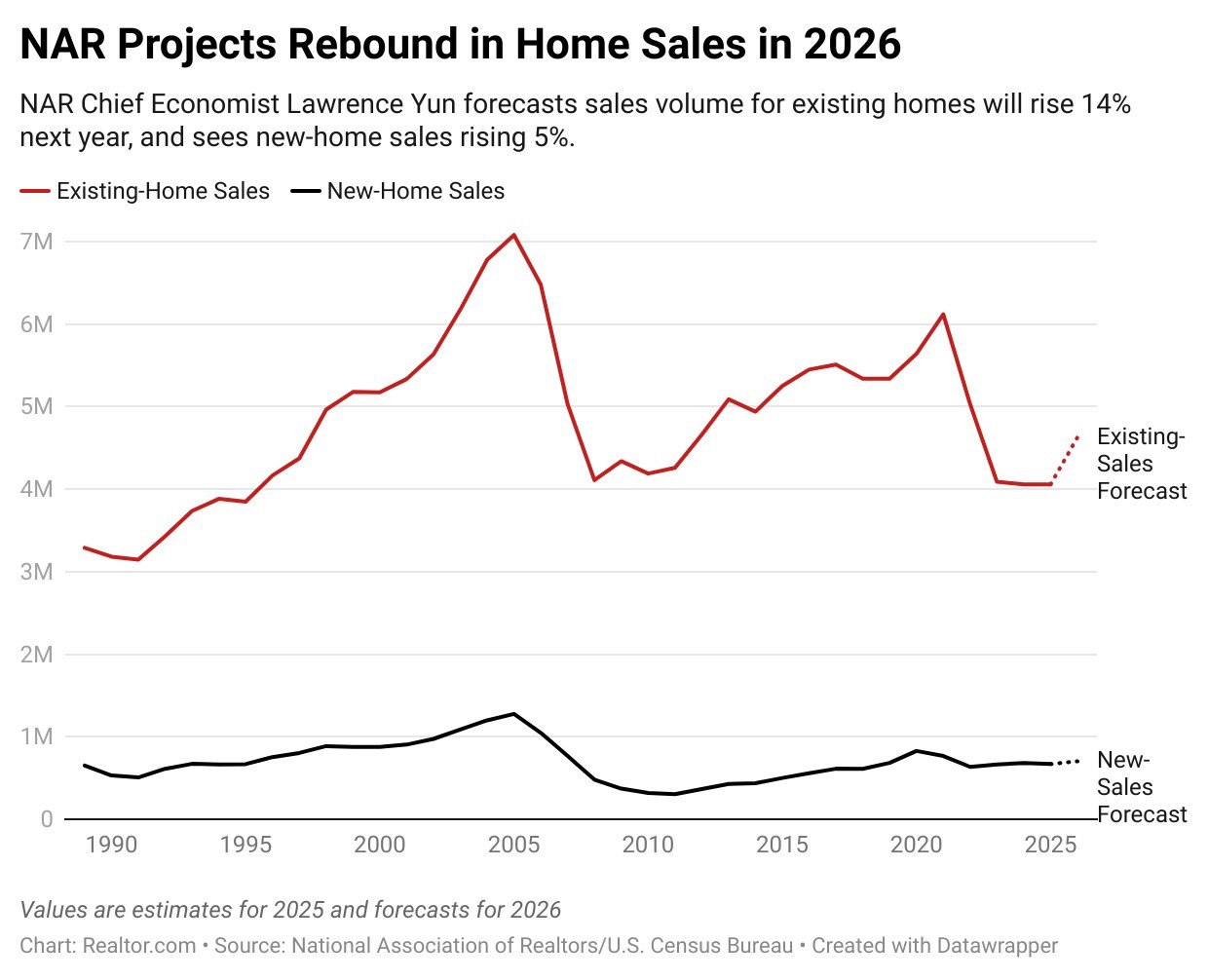The U.S. housing market will finally turn the corner in 2026, with a double-digit increase in home sales supporting a 4% increase in home prices, according to new predictions from the National Association of Realtors®.
NAR Chief Economist Lawrence Yun forecasts sales volume for existing homes will rise 14% next year after three years of stagnation, and sees new-home sales rising 5%.
“Next year is really the year that we will see a measurable increase in sales,” Yun said on Friday at a NAR conference in Houston. “Home prices nationwide are in no danger of declining.”
Yun believes that job growth will remain solid in 2026, with the economy adding 1.3 million jobs. That trend, along with ongoing shortages of available housing supply, will support 4% growth in home prices next year, he predicts.
The optimistic forecast follows three straight years of the lowest volume of home sales since 1995, after affordability concerns pushed many prospective homebuyers to the sidelines.
This year, the typical age of first-time homebuyers rose to an all-time high of 40, in a clear signal that home ownership remains out of reach for many young families.
One year ago, Yun said he hoped that the worst of the housing downturn was over, and predicted that existing home sales would rise 9% in 2025, with new-home sales jumping 11%.
Those forecasts did not come to fruition, with the economist now estimating that existing home sales will remain flat at 0% growth through 2025, and new-home sales will fall 2% from last year.
However, Yun believes that 2026 will be the year that sales finally rebound from multidecade lows, supported by a solid job market and slight easing of mortgage rates.
“Mortgage applications have been consistently above last year, implying that people’s desire to enter the market has been consistently positive,” Yun said.
Modest decline in mortgage rates could boost sales
For months, the Mortgage Bankers Association’s survey data has shown mortgage applications to buy a home have trended well above last year’s level, although so far that trend has not translated to a notable increase in sales.
That’s because a shrinking share of mortgage applications are actually translating into closings, with MBA data showing that in the first half of 2025, just 55% of mortgage applications through banks closed, down from 77% in 2021.
But Yun expects that a gradual improvement in conditions for buyers will translate into more homebuyers closing deals in the coming year.
“As we go into next year, the mortgage rate will be a little bit better,” Yun said. “It’s not going to be a big decline, but it will be a modest decline that will improve affordability.”

The economist forecasts mortgage rates will average around 6% in 2026, down from a roughly 6.7% overall average for this year.
Yun cautions that mortgage rates are unlikely to return to the 3% level seen during the COVID-19 pandemic, but predicts that even minor decreases in mortgage rates could unlock substantial buyer activity.
Boomers continue to dominate housing market
Despite his forecast for a 2026 rebound, Yun acknowledges that the housing market remains deeply uneven, with cash buyers and baby boomers who have substantial equity holding the advantage.
“The upper end of the market has been doing much better than the lower end,” Yun said.
Sales in the $750,000 to $1 million price range have seen some of the largest gains in 2025, while inventory remains constrained at lower price points.
Meanwhile, first-time buyers face steep obstacles to saving up for a down payment, including high rent, student loan debt, and child care costs, says NAR Deputy Chief Economist Jessica Lautz.
“We have haves and have-nots,” she said. “First-time home buyers are really struggling to get in, while those who have housing equity are building credit.”
Recent survey data from NAR showed that first-time buyers accounted for just 21% of homebuyers in 2025, an all-time low. Meanwhile, cash buyers accounted for 26% of sales, an all-time high.
A whopping 30% of repeat buyers paid cash and did not finance their homes, with many of these buyers likely using substantial equity from the sale of a prior home to pay for their new house.

